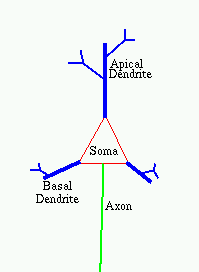- Here is an ODE file illustrating Hebbian learning with two weights -- try it! (Make sure you read all the comments)
- Review of competition models Try simulating some of these. For example, here is the reduced two-dimensional model due to Harris etal. Try changing the parameter N which is the amount of neurotrophin. For small values (N=1) there is strong competetion and only one weight survives; for intermediate values (N=5) there is still competition but the binocular state is stable as well. Finally for large (N=10) values, only the binocular state remains.
- Here is a simulation for occular dominance using 101 units. It is similar to models that we looked at in class.
What is a neuron?
A schematic picture of a neuron

- Soma or cell body which contains all the machinery for keeping the cell alive
- Dendrites: long processes which act to receive signals from other neurons and send them to the soma.
- Axons: processes which send signals to other neurons.
The signals in neuron are electrical and are measured as the difference in potential between the inside and the outside of the cell. This difference is called the membrane potential . Under normal conditions it is about -70 mV .
Signals from the outside and from other neurons tend to change the membrane potential: those that make it more negative are said the hyperpolarize while those that make it more positive are said to depolarize the cell.
Once a cell is sufficiently depolarized and the potential crosses a threshold , ion flows act in a positive feedback to cause the neuron to fire a action potential . Action potentials are generally 100 mV above rest. Action potentials cause short term and long term changes in the cell's ability to fire. In particular, once a cell has fired there is a period of time, the refractory period before which the cell cannot easily fire again. This can last up to several tens of milliseconds.
Once a cell has fired, the action potential travels down the cell's axon where it terminates on a specialized structure called a synapse . Synapses release chemicals called transmitters which depolarize or hyperpolarize the postsynaptic cell's dendrite or soma.
A synapse

Recording cells
- intracellular recordings which measure the potential of the cell relative to the outside. These are able to measure subthreshold responses as well as action potentials. However, they are mainly done only on the soma and are difficult to do in an awake behaving animal.
- extracellular recordings are done near a neuron but not inside the actual cell. They can record action potentials from one or more nearby cells. They are easier to stably maintain and can be done in awake animals.